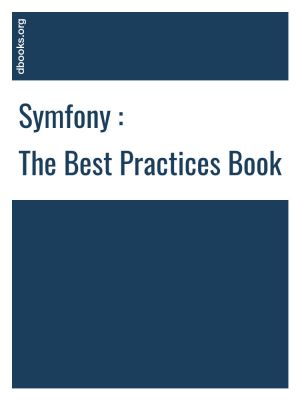Symfony
The Best Practices Book
by Symfony Team
DescriptionTable of ContentsDetailsHashtagsReport an issue
These community resources - like blog posts or presentations - have created an unofficial set of recommendations for developing Symfony applications. Unfortunately, a lot of these recommendations are unneeded for web applications. Much of the time, they unnecessarily overcomplicate things and don't follow the original pragmatic philosophy of Symfony.
This guide aims to fix that by describing the best practices for developing web apps with the Symfony full-stack Framework. These are best practices that fit the philosophy of the framework as envisioned by its original creator Fabien Potencier.
Any Symfony developer, whether you are an expert or a newcomer, can read this guide. But since this isn't a tutorial, you'll need some basic knowledge of Symfony to follow everything. If you are totally new to Symfony, welcome! and read the Getting Started guides first. We've deliberately kept this guide short. We won't repeat explanations that you can find in the vast Symfony documentation, like discussions about Dependency Injection or front controllers. We'll solely focus on explaining how to do what you already know. 
Book Description
The Symfony Framework is well-known for being really flexible and is used to build micro-sites, enterprise applications that handle billions of connections and even as the basis for other frameworks. Since its release in July 2011, the community has learned a lot about what's possible and how to do things best.These community resources - like blog posts or presentations - have created an unofficial set of recommendations for developing Symfony applications. Unfortunately, a lot of these recommendations are unneeded for web applications. Much of the time, they unnecessarily overcomplicate things and don't follow the original pragmatic philosophy of Symfony.
This guide aims to fix that by describing the best practices for developing web apps with the Symfony full-stack Framework. These are best practices that fit the philosophy of the framework as envisioned by its original creator Fabien Potencier.
Any Symfony developer, whether you are an expert or a newcomer, can read this guide. But since this isn't a tutorial, you'll need some basic knowledge of Symfony to follow everything. If you are totally new to Symfony, welcome! and read the Getting Started guides first. We've deliberately kept this guide short. We won't repeat explanations that you can find in the vast Symfony documentation, like discussions about Dependency Injection or front controllers. We'll solely focus on explaining how to do what you already know.
This open book is licensed under a Creative Commons License (CC BY-SA). You can download Symfony ebook for free in PDF format (0.3 MB).
Table of Contents
Chapter 1
The Symfony Framework Best Practices
Chapter 2
Creating the Project
Chapter 3
Configuration
Chapter 4
Organizing Your Business Logic
Chapter 5
Controllers
Chapter 6
Templates
Chapter 7
Forms
Chapter 8
Internationalization
Chapter 9
Security
Chapter 10
Web Assets
Chapter 11
Tests
Book Details
Title
Symfony
Subject
Computer Science
Publisher
Self-publishing
Published
2018
Pages
41
Edition
1
Language
English
PDF Size
0.3 MB
License


